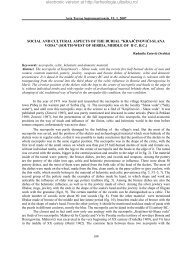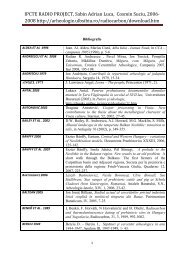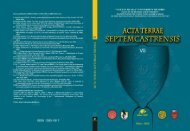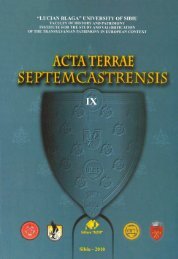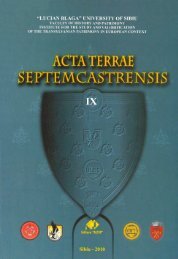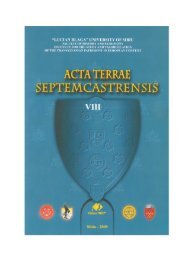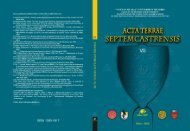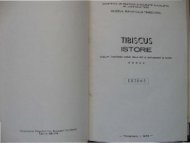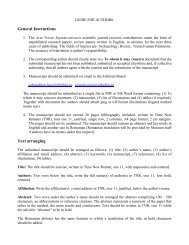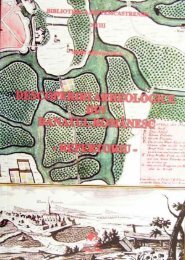acta terrae septemcastrensis viii - Institutul pentru cercetarea Åi ...
acta terrae septemcastrensis viii - Institutul pentru cercetarea Åi ...
acta terrae septemcastrensis viii - Institutul pentru cercetarea Åi ...
You also want an ePaper? Increase the reach of your titles
YUMPU automatically turns print PDFs into web optimized ePapers that Google loves.
Acta Terrae Septemcastrensis, VIII, 2009<br />
cultural development that includes writing technology. Within this model, ars<br />
scribendi does not guarantee statehood, however it is an obliging ingredient and<br />
supportive device. Traditionally the Mesopotamian state-bureaucratic model is<br />
believed to be the original setting for the dawn of civilization and literacy to which<br />
all the other regions had to conform. See, for example, the Indus civilization which<br />
“because of its scale, urbanism, iconography and other attributes . . . has been<br />
forced into the classificatory straightjacket of ‘state’ or even ‘empire’” (Maisels<br />
1999: 220). Alternatively, see the narration of the dawn of writing technology in<br />
Minoan society (Godart 1992).<br />
Crossing territorial and chronological data, DatDas provides documentary<br />
evidence that in the Neolithic and Copper Age of Southeastern Europe a<br />
civilization emerged that was organized as a network of nodes along politicalinstitutional,<br />
socio-economic and cultural spheres. In contrast to the statebureaucratic<br />
model, the historical situation that produced the Danube script was<br />
similar to the Harappan civilization in the ancient Indus valley. Maisels (1999)<br />
utilizes the term oecumene to define a society that is the opposite of a “territorial<br />
state” and synonymous with a commonwealth in the sense of an “economically<br />
integrated commerce-and-culture area.” The Danube civilization qualifies as an<br />
oecumene in the sense that the interconnected cultures within Southeastern Europe<br />
composed a “disparate, overlapping and interactive sphere of authority: economic,<br />
political, religious and, only derivatively, territorial” (See Maisels 1999: 236-7, see<br />
also 224, 226, 252 ff.). Haarmann was the first to utilize this concept for the<br />
Danube civilization (Haarmann 2003: 154 ff., 2008a: 26-7).<br />
What do we know about the synchronic and diachronic relationship between<br />
settlements in the Danube civilization Some paradigms taken from social network<br />
analysis can be usefully applied to describe, analyze, and explain the relations<br />
between them. A social network is defined as a specific social structure,<br />
community, or society made of linkages among a definite set of nodes or actors<br />
(i.e., discrete individual or collective social units linked to one another by social<br />
ties) (Mitchell 1969: 2). The social network perspective focuses on structured<br />
connections among entities and not on the attributes of the units assumed to be<br />
independent actors. The aim of this kind of analysis is to discovery and explain the<br />
structure of a given network indicating the ways in which actors are connected<br />
(Schweizer 1996: 166; Wassermann and Faust 1994: 17; Scott 2000; Speck<br />
2007). 5 Utilizing correspondence analysis of territorial spread and chronological<br />
sequence of the Danube script, a civilization emerged which was organized as a<br />
hierarchical and multi-mode network of nodes along three spheres: politicalinstitutional,<br />
socio-economic and cultural. The network or oecumene model of the<br />
Danube civilization―as appearing from the standpoint of the script within the<br />
frame of social network analysis―centers on features of (a) a web of politically<br />
ranked urban centers and micro-regions; (b) a socio-economic oecumene, i.e., an<br />
economically integrated commerce-and-culture area (see Maisels 1999: 236-7,<br />
5 See Classen 2004 in terms of the application of this analytical approach on<br />
communication networks between settlements of the Bandkeramik in the Rhineland.<br />
45



